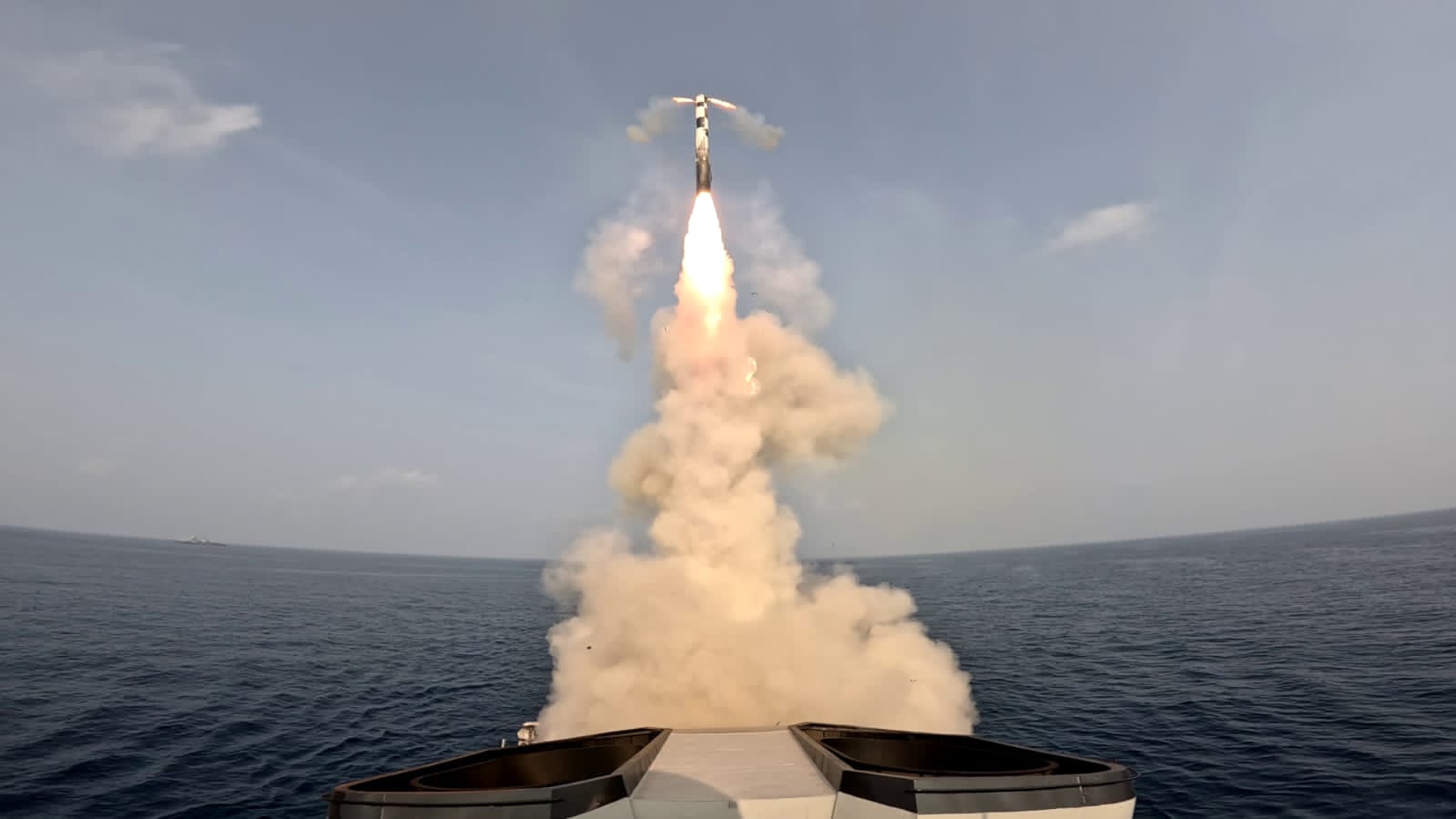After tasting success with BrahMos Aerospace, an Indo-Russian joint venture, India’s Bharat Electronics Limited (BEL) is now setting up a joint venture with French Safran Electronics and Defence (SED) to manufacture the HAMMER (Highly Agile Modular Munition Extended Range) weapon system in India.
“In a major impetus to Make-in-India and Aatmanirbhar Bharat as envisioned by Prime Minister Shri Narendra Modi, Bharat Electronics Limited (BEL) and Safran Electronics and Defence (SED), France have signed a Joint Venture Cooperation Agreement (JVCA) for the production of Highly Agile Modular Munition Extended Range (HAMMER) Smart Precision Guided Air-to-Ground Weapon in India,” the Indian Ministry of Defense (MoD) said in a statement on November 24.
As per details revealed by the MoD, the JVCA will be established as a 50/50 private limited company. It will localise the production, delivery, and maintenance of HAMMER, which will be integrated with the Indian Air Force (IAF) and the Indian Navy.
The degree of indigenisation will gradually rise to 60%, with important mechanical, electronic, and sub-assembly components being produced domestically, as per the MoD. BEL will oversee final assembly, testing, and quality assurance during the phased transfer of production.
The BrahMos joint venture—launched in 1998 by India’s DRDO and Russia’s NPO Mashinostroyeniya—has spent nearly three decades perfecting the world’s fastest supersonic cruise missile and arming the Indian Army, Navy, and Air Force.
However, the HAMMER joint venture differs from the BrahMos JV in several ways.
BrahMos Aerospace was established by two sovereign governments under an intergovernmental agreement, whereas the HAMMER joint venture is a result of an agreement between two companies, one Indian and one French.
BrahMos Aerospace was set with an initial capital of $300 million, split 50.5% Indian and 49.5% Russian — a deliberate structure that gives New Delhi the controlling stake and final say in all strategic decisions.
While Russia remains an indispensable technology partner, India’s slim majority ownership ensures Moscow plays a junior financial and decision-making role. The joint venture, supported by over 200 Indian private firms and Russian defence giants like NPO Mashinostroyeniya, handles end-to-end design, development, production, and global marketing of the BrahMos missile system.
In contrast, the HAMMER JCAV is focused on the localisation of manufacturing, supply, and maintenance of HAMMER kits for India. It has no provision for research and development or further upgrade of the weapon system. Both companies have a 50-50 partnership.
The BrahMos supersonic cruise missile has been aggressively promoted for export. The Philippines has already signed for three shore-based batteries (the first export order), while Indonesia, Vietnam, Malaysia, and several Middle Eastern nations are at various stages of evaluation and negotiation.
Both India and Russia, however, must approve the sale of the missile.
On the other hand, there is currently no emphasis on exporting the HAMMER weapon system, produced in India, to a third party.

BrahMos Aerospace is the cornerstone of the India-Russia strategic partnership. It was the first major Indo-Russian JV after the Cold War and is now involved in developing more advanced variants of the BrahMos missile, such as the BrahMos-NG.
Meanwhile, the HAMMER JCAV is part of the “Make in India” push and strictly focuses on manufacturing the existing weapon, with potential for expansion in the future.
Nonetheless, it is pertinent to note that HAMMER JV diversifies India’s missile sourcing away from Russia amid global tensions, whereas BrahMos underscores enduring Indo-Russian ties despite Western sanctions.
Moreover, it should be noted that both JVs produce completely different types of missiles and are therefore not directly comparable.
India Producing Russian & French-Origin Weapons
The AASM HAMMER is a weapon that may be customised with multiple guidance systems, including laser, infrared seeker, and satellite guidance. Safran claims that the AASM HAMMER can be fired from 20 to 70 kilometres, allowing the launch aircraft to remain outside the enemy’s air defence system.
A 500-pound or 250-kilogram class iron bomb is attached to a range-extension kit (REK) positioned on the tail and a guidance section mounted on the nose in the baseline model of HAMMER bombs.
One component of the range expansion segment is a solid-fuel rocket. According to Safran, this offers the 500-pound/250-kg class version a range of at least 43 miles (70 kilometres), depending on the release envelope; however, more on that later. If desired, hammer munitions can also be used in an unpowered mode with a shorter range.
Additionally, hammer kits have been designed for use with bombs weighing 100, 500, and 1,000 kilograms. According to Safran, HAMMERS may be configured to use general-purpose high-explosive and bunker-buster-type bombs.
A GPS-assisted inertial navigation system (INS) package, designed to attack specified preset target coordinates, is the primary guidance system used on all HAMMER bomb variants. HAMMER bombs reportedly use IIR or SALH homing for terminal guidance and a mix of SATNAV and INS for navigation.
Safran provides semi-active or imaging infrared homing options for multi-mode guidance, facilitating the engagement of moving targets and enhancing overall accuracy. This provides additional navigation options when GPS is unavailable.
Although the HAMMER has a Talios pod for firing, the IAF has chosen the Israeli Litening Pod for the Rafale to maintain sensor commonality across platforms in the Indian inventory and to keep costs down, as Talios was almost twice as expensive as the Israeli system.
In July 2021, the IAF deployed Rafale equipped with HAMMER amid heightened tensions with China. As per reports, the IAF also deployed this deadly combo during Operation Sindoor, against Pakistan, in May this year.
Many defence experts pointed out that India selected the HAMMer for this crucial operation because of its complete autonomy and immunity to jamming.
BrahMos, on the other hand, is one of the world’s fastest supersonic cruise missiles, and it can be launched from submarines, ships, aircraft, or land platforms. It is also part of India’s nuclear triad, which allows the country to strike back after being hit by a nuclear weapon.
The BrahMos missile is a two-stage weapon. The missile launches with a solid-fuel booster, which detaches after take-off. A liquid-fuelled ramjet engine then propels it at speeds approaching Mach 3.
The missile works on a “fire and forget” principle, meaning once launched, no further guidance is required. And, its terrain-hugging trajectories, low radar signatures, and high kinetic energy make it very difficult to intercept.

The BrahMos is a lethal, high-speed, precision, stand-off missile that can be launched from the ground, sea, and air. The Indian Navy inducted its first BrahMos system in 2005 aboard INS Rajput.
The Indian Army followed in 2007 with its own regiments, and the Air Force later introduced an air-launched version from the Sukhoi-30MKI aircraft in 2019. In fact, India launched 15-19 BrahMos missiles during the four-day conflict with Pakistan.
Though tested for years, Operation Sindoor likely marked the BrahMos system’s first real combat deployment, where its speed, accuracy, and deep-strike capability were brought to bear with devastating effect.
As India’s go-to supersonic missile, BrahMos has now moved from deterrence to decisive action. BrahMos is not just a missile—it’s a statement of India’s technological prowess and strategic intent.
- Contact the author at sakshi.tiwari13 (at) outlook.com
- Follow EurAsian Times on Google News




